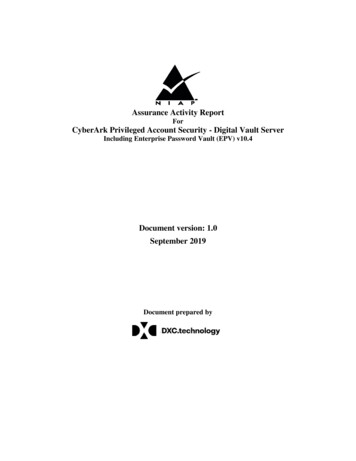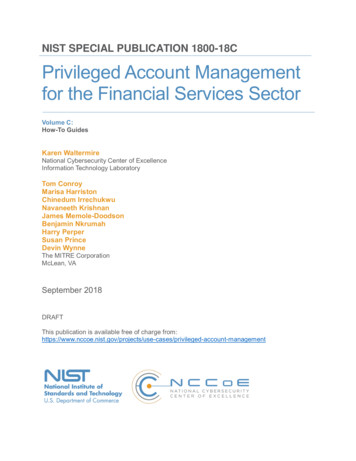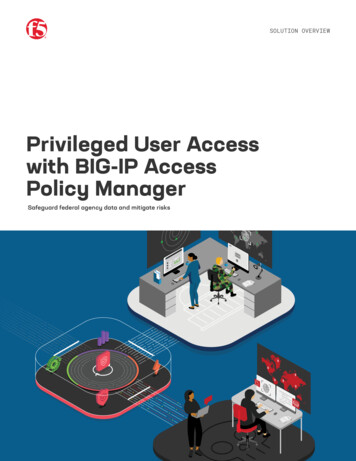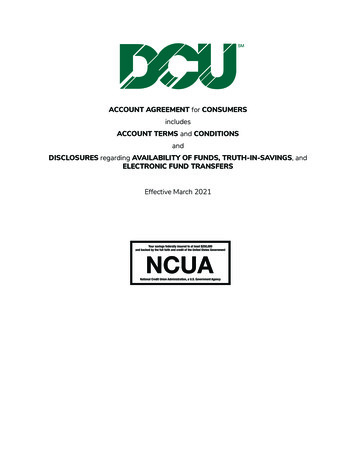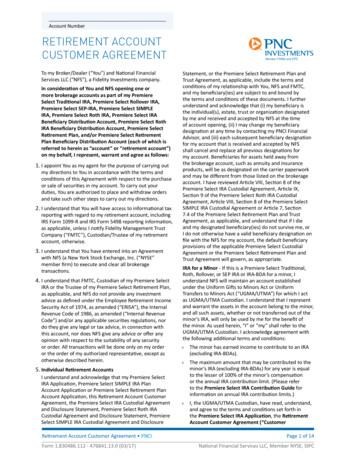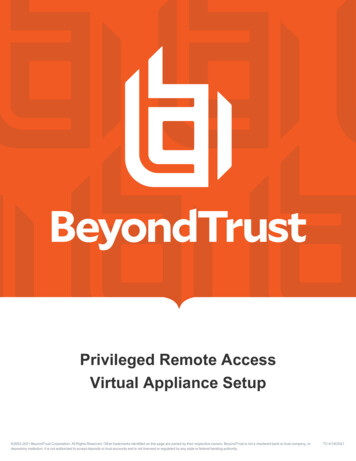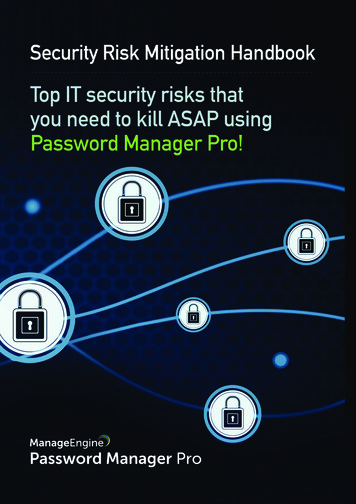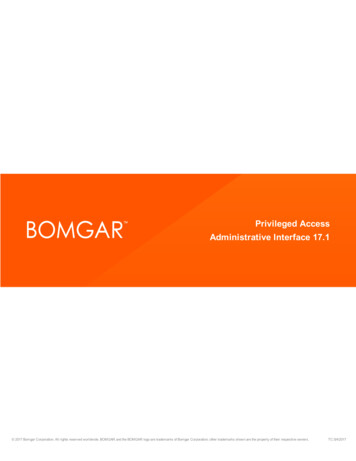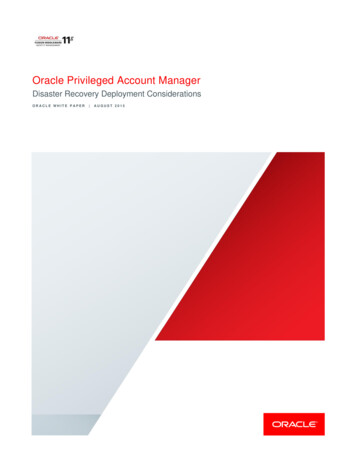
Transcription
Oracle Privileged Account ManagerDisaster Recovery Deployment ConsiderationsORACLE WHITE PAPER AUGUST 2015
DisclaimerThe following is intended to outline our general product direction. It is intended for informationpurposes only, and may not be incorporated into any contract. It is not a commitment to deliver anymaterial, code, or functionality, and should not be relied upon in making purchasing decisions. Thedevelopment, release, and timing of any features or functionality described for Oracle’s productsremains at the sole discretion of Oracle.ORACLE PRIVILEGED ACCOUNT MANAGER DISASTER RECOVERY DEPLOYMENT CONSIDERATIONS
Table of ContentsDisclaimer1Introduction2Oracle Privileged Account Manager Overview3Oracle Privileged Account Manager Disaster Recovery Architecture4Steps Required for Disaster Recovery FailoverOracle Privileged Account Manager Disaster Recovery Scenario FAQResources1 ORACLE PRIVILEGED ACCOUNT MANAGER DISASTER RECOVERY DEPLOYMENT CONSIDERATIONS7911
IntroductionThe goal of this paper is to provide an overview of the high level design considerations for deployingOracle Privileged Account Manager (OPAM) in a Disaster Recovery (DR) Environment. This paperwalks through a Disaster Recovery scenario to outline what high level steps a failover requires. OPAMis part of the overarching Oracle Identity Governance Suite, but for the purposes of this paper thefocus will be on the OPAM component only. This paper is intended to give the reader anunderstanding of what steps a failover requires, what additional software may be required, whatdatabase options should be considered, and other information to help architect an OPAM opportunity.The paper will not discuss implementation details as these will vary widely depending on thecustomer’s environment.2 ORACLE PRIVILEGED ACCOUNT MANAGER DISASTER RECOVERY DEPLOYMENT CONSIDERATIONS
Oracle Privileged Account Manager OverviewOracle Privileged Account Manager manages privileged accounts that are not being managed by any other OracleIdentity Management components. Accounts are considered "privileged," if they can access sensitive data, cangrant access to sensitive data, or can both access and grant access to that data. Privileged accounts are yourcompany's most powerful accounts and they are frequently shared.For more information on what OPAM is and why it should be used, please are/id-mgmt/overview/opam-wp-11gr2-1697093.pdfWhen OPAM is deployed within an enterprise, the enterprise may use OPAM to manage a high degree of theirprivileged accounts via the OPAM password vault and OPAM session manager. Due to the importance of theseaccounts, it becomes imperative that OPAM can be deployed in a highly available environment and that disasterscenarios can be handled as quickly as possible to ensure these accounts are available to allow the enterprise tocontinue critical operations.OPAM is a critical part of the Identity Governance Suite (consisting of Oracle Identity Manager and OPAM) becauseof the “real time access” it manages for privileged accounts. A prolonged OPAM outage can be more damaging toan organization than an Oracle Identity Manager outage because privileged accounts needed to run the enterprisemay not be accessible. Therefore, understanding the Disaster Recovery Failover options for OPAM becomesimportant in the early implementation stages as a customer calculates the total cost of ownership for thecomponents required to implement a successful Disaster Recovery strategy.For the purposes of this document, it’s important to understand the basic architecture of a single instance of OPAM.Figure 1: Oracle Privileged Account Manager Single Instance ComponentsOPAM is deployed in a standard 3 tier architecture. The Web tier (not pictured in Figure 1) acts as a reverse proxyfor the OPAM (web-based administration) Console Application. The Application tier runs all of OPAM’s corecomponents within a single WebLogic domain. These components include the OPAM (administration) console, thecore OPAM server, and the OPAM session manager. OPAM stores its application data and password vaultinformation in an Oracle database. It is recommended the Oracle DB is encrypted using Advanced Security Option(a restricted license is included with OPAM). The OPAM schema is created in the Oracle database via the OracleRepository Creation Utility. Oracle Privileged Session Manager relies on the OPAM Database for persistence andcommunicates with OPAM through its RESTful interfaces. The Oracle Platform Security Services (OPSS) identity3 ORACLE PRIVILEGED ACCOUNT MANAGER DISASTER RECOVERY DEPLOYMENT CONSIDERATIONS
store and the OPSS security store (which includes the Policy Store and credential store) are WebLogic domain-wideconstructs, so there is one of each per domain. The OPSS identity store can point to the LDAP directory embeddedin WebLogic (out of the box) or to an external LDAP server (not pictured in Figure 1).For high availability and disaster recovery it is important that the web tier, the application tier (WebLogic), the datatier (Oracle database), and the identity store are scaled appropriately. This paper does not cover detailed sizingguidelines for OPAM. These can be obtained from Product Management. When sizing, one should consider theserver specifications as well as storage specifications required for storing session information on targets. OnceOPAM has been sized based on the customer’s throughput characteristics, then high availability within a single datacenter and disaster recovery across multiple data centers can be considered. It is important to take into accountwhat the customer’s definition of high availability and DR are, as many customers have different approaches. TheFusion Middleware Enterprise Deployment Guide for Oracle Identity Management provides good baseline guidanceon this topic.Oracle Privileged Account Manager Disaster Recovery ArchitectureAs of the writing of this document, OPAM is officially supported to run in an active/passive configuration for multi siteDisaster Recovery (DR). This means that the production instances of OPAM are active, whereas the DRcomponents of OPAM are passive. The passive designation means that the host system will be running but theOPAM WebLogic Instance will not be running during normal operation. Note that OPAM can be configured to runActive/Active within a single datacenter in a high availability configuration, but this paper is focusing on theactive/passive configuration for a multi site deployment. Let’s take a moment to understand what each component inthe architecture is doing during normal operation. There are several key assumptions to understand during thisdiscussion.Figure 2: OPAM Prod and Disaster Recovery High Level ArchitectureAssumptions: The Oracle DB in Production and DR is 2 (or more) instances of RAC. Oracle DB comes with Data Guard. Data guard handles the replication of data from the prod DB tier to theDR DB tier during normal operation using a variety of configurations.4 ORACLE PRIVILEGED ACCOUNT MANAGER DISASTER RECOVERY DEPLOYMENT CONSIDERATIONS
Data Guard can also enable role transition to switch the DR DB from standby to primary during a DRscenario. This can be configured to occur automatically or manually. Active Data Guard is used for a specificpurpose outlined in the FAQ section of this paper. OPAM3 and OPAM4 are assumed to be preconfigured with appropriate targets and then turned off. The WebLogic Server in DR is assumed to be off and OIGHost3 and OIGHost4 are on. The WebHosts (1-4), local load balancer, and global load balancer configuration are not in scope for thispaper. Customers have many different methods of configuring these components, whether they are usingOracle Http Server, Apache, or another Web server. Similarly, local and global load balancers may beimplemented different ways. The Enterprise Deployment guide suggests the recommended method todeploy these components. For the purposes of the paper, we will assume that the customer has the meansto route to web tiers as needed.Normal Operation:During Normal Operation, the components below will be working as described:Production Web tier:This tier may vary depending on the customer. Generally Load Balancer 1 will balance the traffic to the 2 webhostnodes (1 & 2) for HA. If one webhost (webhost1) is unresponsive, Load Balancer 1 routes all traffic to the otherwebhost (webhost2). The webhost nodes will route the traffic to the OPAM 1 and OPAM 2 instances for HAconfiguration within the production datacenter.Production Application Tier:The application tier will consist of 2 (or more) physical hosts for high availability. Each physical host will be running aWebLogic instance of OPAM. This enables an HA configuration of OPAM in the production datacenter. If one OPAMnode (OPAM 1) is unresponsive, webhost1 and webhost2 will need to route the traffic to OPAM 2.Note: For clients utilizing the OPAM API, an additional Load Balancer in front of OPAM 1 and OPAM 2 can be usedto balance API calls between the 2 OPAM instances. Note this traffic is assumed to be internal network traffic. Fortraffic originating externally, other considerations need to be made.Note: OPAM1 and OPAM2 WebLogic instances can utilize the high availability built into the Oracle RAC database.The Oracle RAC database can be configured as a JDBC multi data source or GridLink data source to protect theinstance from Oracle RAC node failure. GridLink is the recommended method of building in high availability andoffers top of the line capabilities for automatic failover. GridLink can be enabled when the “Active Gridlink” feature ofWebLogic Suite is licensed (WebLogic Suite is not included in the restricted use license of WebLogic ServerEnterprise Edition that comes with the Identity Governance Suite). Active Gridlink allows the WebLogic instances tobe “RAC aware” and communicate on the same back channel that the RAC nodes communicate on. This enablesthe WebLogic server to automatically know when a RAC is down or up and connect to it accordingly without manualintervention. The JDBC multi data source configuration is not as automatic, but can also be used to configuremultiple RAC DB connections. JDBC multi data source is used by many customers today.Production Data Tier:The production data tier is using Oracle RAC database with 2 or more RAC nodes. This enables quick failover withinthe production site if there is a RAC node failure. During normal operation, Oracle Data Guard will replicateproduction data to the DR (standby) RAC database.5 ORACLE PRIVILEGED ACCOUNT MANAGER DISASTER RECOVERY DEPLOYMENT CONSIDERATIONS
Production LDAP:OPAM relies on and transparently uses the ID Store and Policy Store configured for the WebLogic domain in whichOPAM is deployed. All OPAM users and administrators are authenticated using this identity store. It isrecommended that customers use a LDAPv3 compliant directory for this purpose. In the production datacenter, theLDAP identity store should be highly available so it can be accessed by the OPAM1 or OPAM2 WebLogic serverinstances.DR site during normal operation:Many customers choose to have a scaled down deployment of OPAM in DR. Depending on the customer’s riskanalysis, it may be acceptable to have a scaled down DR environment, although the general recommendation is toprovide a reliable service even in disaster scenarios. For the purposes of this discussion, we have assumed that thecustomer has an identical deployment in Production and DR.DR Web tier:This tier may vary depending on the customer. It is going to function similar to the production web tier. Duringnormal operation the web tier can be turned on and ready to route traffic or it can be turned off awaiting a call toaction.DR Application Tier:OPAM supports an Active/Passive deployment for Prod/DR. This means that the WebLogic Server(s) will need to bepassive in DR. Assuming the WebLogic tier in DR is connecting to the Oracle DB tier in DR, the DB will be instandby mode until a DB role transition is complete (this is a step in the database failover process). The DRWebLogic Server won’t start up properly until the DR DB is made primary. Therefore, during a failover, the DRWebLogic instance needs to be started/restarted in order for the OPAM application to successfully connect to theDR DB (which has transitioned its role to primary). There is some flexibility here depending on the implementation ofWebLogic server, for example, scripts can be used to automate some of this process. For the purposes of thisdiscussion, the physical host for the WebLogic Server(s) in DR will be turned on, but WebLogic Server will be offduring normal operation.DR Data Tier:The DR data tier is using Oracle RAC database with 2 or more RAC nodes. This enables the redundancy andavailability benefits of RAC within the DR site. During normal operation, Oracle Data Guard will replicate productiondata to the DR standby database.DR LDAP:OPAM relies on the ID Store and Policy Store configured for the WebLogic domain in which OPAM is deployed. InDR, the LDAP identity store should be highly available so it can be accessed by the OPAM WebLogic serverinstances. LDAP replication from Prod to DR should be in place so the DR LDAP is available at all times.6 ORACLE PRIVILEGED ACCOUNT MANAGER DISASTER RECOVERY DEPLOYMENT CONSIDERATIONS
Steps Required for Disaster Recovery FailoverCustomers want to know what high level steps and credentials are required for a DR failover to occur. Since thecurrent release of OPAM supports an Active/Passive deployment in Production/DR, there will be some manualcomponents to the failover process for the OPAM instance. Furthermore, Data Guard failover steps vary dependingon whether Data Broker is used, manual steps are taken, or Fast Start Failover is utilized. For details how DataGuard can be used to failover the Oracle Database l 14.htmOracle Site Guard can automate the failover process for all of a customer’s infrastructure components in all tiers.Depending on the complexity of the customer’s environment and the number of manual steps that are required, SiteGuard may make sense for the customer to automate as much as possible during a failover scenario. Site Guardallows you to extend the built in disaster recovery functionality of Oracle components by allowing you to insetcustom scripts at specific points during the operation workflow. It includes the capability to perform pre-checks,health checks, storage integration, monitoring, credential management, and more. Site Guard is not in scope for thispaper, but additional information can be found here:http://docs.oracle.com/cd/E24628 01/server.121/e52894/concepts.htm#GUARD126The below example gives a simplistic high level overview of the steps required to failover the database. The failurescenario for this discussion assumes that there is a geographic outage and multiple components in multiple tiers inProduction are failing. In this scenario, the customer will need to follow some high level steps to failover to the DROPAM.High Level Failover Steps Required:1. The Oracle DB used by OPAM will be failed over to the DR site using one of the methods made availablethrough Data Guard.2. The WebLogic Server is brought up after the DR DB instance has been transitioned to the primary DB. Thereare various methods to do this, either manually, using custom scripts, or using Site Guard.3. The Web Tier components need to be started in the DR Site.4. Connectivity is confirmed for all DR components. Global traffic needs to be routed to the DR site via a LoadBalancer configuration or utilizing Domain Name Services re-configuration.Note: The steps above will vary greatly depending on the customer environment. For example, the DNS changemay be required before anything else to ensure all the components can communicate within the DR site before theglobal traffic is routed to DR. It is important to understand the steps your customer uses today and provide a generalguideline for how OPAM can fit into that process. The implementation partner should be involved in this discussion.7 ORACLE PRIVILEGED ACCOUNT MANAGER DISASTER RECOVERY DEPLOYMENT CONSIDERATIONS
OPAM Credential Storage ConsiderationsA commonly asked question is: how can OPAM can be started in DR if OPAM’s infrastructure credentials areprotected by OPAM itself and there is an OPAM outage? OPAM’s infrastructure credentials may include theWebLogic administration account required to start WebLogic, the Oracle DBA account to perform DB failoveroperations, and other accounts that are required to start up and troubleshoot OPAM in the Production and DRenvironment. This is an interesting chicken and egg scenario, however, it is recommended that all OPAMinfrastructure credentials required to start OPAM and all its dependent components are NOT protected by OPAM.The simple reason is you do not want to place the keys to the vault inside the vault. For example, the followingcredentials should not be stored inside OPAM: DBA account for OPAM DB – This can be stored in an external password store (Oracle wallet). WLS admin account for starting WLS domains – This can be encrypted in the boot identity file. The WLSstartup script will use those encrypted credentials to start WLS, so the administrator does not need to knowthe credentials. OS Credentials for OPAM WebLogic Server and DB hosts – These should be kept outside of OPAM in asecure location.Note: One method to address this scenario is to use a lower environment (QA/Test) to protect the OPAMinfrastructure credentials in Production and to use the Production environment to protect the lower environment’sOPAM infrastructure credentials. This gives administrators a way to get the OPAM WebLogic Server, DB, and OSpasswords for starting up OPAM in DR, even if OPAM goes down in production. However, it still does not help youduring a wide reaching outage that may take down your lower environments in addition to your productionenvironment.Note: Another option is available for customers that own Oracle Database Vault. This method will limit the numberof OPAM infrastructure credentials they need to track and safeguard. . The customer can allow the “oracle” OSaccount to start up the OPAM DB and the WebLogic Server so no other credentials are required to start up theOPAM infrastructure. This OS user account can start up WLS and the Oracle DB without requiring furtherauthentication. The advantage of this option is that no additional passwords/credentials are required to startup theDR OPAM infrastructure assuming there is no troubleshooting required during the startup of DR. The disadvantageof this option is that it opens up the Oracle DB to individuals that have the “oracle” account credentials. Therefore, itis best practice to use Database Vault to control what commands the “oracle” OS account is allowed to execute onthe Oracle DB.Note: Oracle Site Guard also provides functionality for creating and storing preferred credential associations in asecure manner so the infrastructure credentials required to start up components can be stored in EnterpriseManager.8 ORACLE PRIVILEGED ACCOUNT MANAGER DISASTER RECOVERY DEPLOYMENT CONSIDERATIONS
Oracle Privileged Account Manager Disaster Recovery Scenario FAQDoes OPAM run in Active/Active multi data center deployment?No, OPAM supports Active/Passive deployment.Why Does OPAM only work in Active/Passive Deployment?The limitation occurs at the WebLogic layer. When you have a primary WLS cluster using a primary DB RAC clusterin normal operation, a DR failover will need to quickly enable all the components in DR starting with the DB, then theWLS tier, then the Web Tier, and finally to route all traffic to DR. Oracle DB uses Data Guard to automaticallyfailover to the standby RAC cluster in DR (and enable a ro
privileged accounts via the OPAM password vault and OPAM session manager. Due to the importance of
